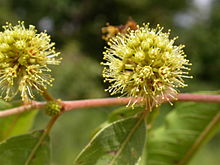Terminalia leiocarpa
| Terminalia leiocarpa | |
|---|---|

| |
| Anogeissus leiocarpa flowers in Burkina Faso | |
| Scientific classification | |
| Kingdom: | Plantae |
| Clade: | Tracheophytes |
| Clade: | Angiosperms |
| Clade: | Eudicots |
| Clade: | Rosids |
| Order: | Myrtales |
| Family: | Combretaceae |
| Genus: | Anogeissus |
| Species: | A. leiocarpa
|
| Binomial name | |
| Anogeissus leiocarpa (DC.) Guill. & Perr.
| |
Anogeissus leiocarpa (African birch; Template:Lang-bm) is a tall deciduous tree native to savannas of tropical Africa.[1] It is the sole West African species of the genus Anogeissus, a genus otherwise distributed from tropical central and east Africa through tropical Southeast Asia.[1] A. leiocarpa germinates in the new soils produced by seasonal wetlands and grows at the edges of the rainforest, although not in the rainforest, in the savanna, and along riverbanks forming gallery forests. The tree flowers in the rainy season, from June to October. The seeds, winged samaras, are dispersed by ants.
Ethnobotany
It is one of the plants used to make bògòlanfini, a traditional Malian mudcloth. Small branches with leaves are crushed to make one of the yellow dyes.[2] The inner bark of the tree is used as a human and livestock anthelmintic for treating worms, and for treatment of a few protozoan diseases in animals, nagana (an animal trypanosomiasis), and babesiosis.[3] The inner bark is used as a chewing stick in Nigeria and extracts of the bark show antibacterial properties.[4] The stem barks contains castalagin[5] and flavogallonic acid dilactone.[6]
References
- ^ a b Steentoft, Margaret (1988). Flowering Plants in West Africa. Cambridge University Press. ISBN 0-521-26192-9.
- ^ Arbonnier, Michel (2004). Trees, Shrubs and Lianas of West African Dry Zones. Quae. ISBN 2-87614-579-0.
- ^ Bizimana, Nsekuye (1994). Traditional Veterinary Practice in Africa. German Technical Cooperation. ISBN 3-88085-502-1.
- ^ Mann, A.; Yahaya, Y.; Banso, A.; Ajayi, G. O. (March 2008). "Phytochemical and antibacterial screening of Anogeissus leiocarpus against some microorganisms associated with infectious wounds". Academic Journals.
{{cite journal}}: Cite journal requires|journal=(help) - ^ Shuaibu, M. N.; Pandey, K.; Wuyep, P. A.; Yanagi, T.; Hirayama, K.; Ichinose, A.; Tanaka, T.; Kouno, I. (2008). "Castalagin from Anogeissus leiocarpus mediates the killing of Leishmania in vitro". Parasitology Research. 103 (6): 1333–1338. doi:10.1007/s00436-008-1137-7. PMID 18690475.
- ^ Shuaibu, M. N.; Wuyep, P. A.; Yanagi, T.; Hirayama, K.; Tanaka, T.; Kouno, I. (2008). "The use of microfluorometric method for activity-guided isolation of antiplasmodial compound from plant extracts". Parasitology Research. 102 (6): 1119–1127. doi:10.1007/s00436-008-0879-6. PMID 18214539.
External links
